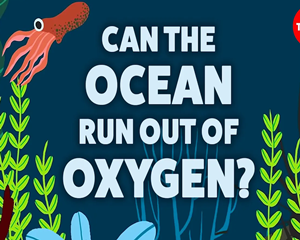For most of the year, the Gulf of Mexico is teeming with marine life, from tiny crustaceans to massive baleen whales.
在一年的大部分时间里,墨西哥湾充斥着丰富的海洋生物,从微小的甲壳类动物到巨大的长须鲸。
But every summer, disaster strikes. Around May, animals begin to flee the area.
但是每年夏天,灾难都会来临。大约在5月的时候,海洋动物们开始从那里逃离。
And soon, creatures that can't swim or can't swim fast enough begin to suffocate and die off in massive numbers.
很快,那些不会游泳或游得不够快的生物开始窒息,甚至大量死亡。
From late spring to early autumn, thousands of square kilometers along the coast become a marine dead zone -- unable to support most forms of aquatic life.
从春末到秋初,沿海数千平方公里的海域变成了海洋生命的死亡地带--大多海洋生物无法生息。
This strange annual curse isn't unique; dead zones like this one have formed all over the world.
这每年一次的怪异诅咒,并非独一无二;像这样的死亡地带已散布于世界各地。
But to explore what's creating these lethal conditions, we first need to understand how a healthy marine ecosystem functions.
要想探寻导致这些致命环境形成的原因,我们先要了解一个健康的海洋生态系统是如何运作的。
In any body of water that receives sufficient sunlight, plant-like organisms such as algae and cyanobacteria thrive.
在任何阳光照射充足的水体中,藻类和蓝藻细菌等类似植物的生物体会生长得很茂盛。
Clouds of algae streak the surface of deep waters, and in shallower regions, large seaweeds and seagrass cover the ground.
深水区域的表面,有成群的水藻,在较浅的区域,大型海藻和海草覆盖着海底的地面。
Not only do these organisms form the foundation of local food chains, their photosynthesis provides the oxygen necessary for aquatic animals to survive.
这些生物不仅形成了当地食物链的基础,它们的光合作用也提供了海洋动物生存所需的氧气。
Besides sunlight and C02, algae growth also depends on nutrients like phosphorus and nitrogen.
除了阳光和二氧化碳,水藻的生长也需要依赖于营养物质,例如磷和氮。
While such resources are typically in short supply, sometimes the surrounding watershed can flood coastal waters with these nutrients.
这些资源经常短缺,有时周围流域的营养物质会将沿海的水域淹没。
For example, a large rainstorm might wash nutrient-rich sediment from a forest into a lake.
例如,一场大暴雨可能会把森林中富含营养物质的沉积物冲入湖中。
These additional resources lead to a massive increase in algae growth known as eutrophication.
这些额外的资源会导致藻类的生长大量增加,被称为“富营养化”。
But rather than providing more food and oxygen, this surge of growth has deadly consequences.
但这种激增不仅没有提供更多的食物和氧气,反而造成了致命的后果。
As more algae grows on the surface, it blocks sunlight to the plants below.
随着更多藻类在水面生长,阻挡了海下植物生长所需的阳光。

These light-deprived plants die off and decompose in a process which uses up the water's already depleted oxygen supply.
这些因失去光照而死亡的植物,在分解的过程中进一步耗尽了海水中已经枯竭的氧气供应。
Over time, this can reduce the oxygen content to less than 2 milligrams of oxygen per liter, creating an uninhabitable dead zone.
随着时间的推移,这可能会使氧气含量减少到每升不到2毫克的氧气,形成一个不适合生息的死亡地带。
There are rare bodies of water that rely on natural eutrophication.
有少数的水体要依赖天然的“富营养化”。
Regions like the Bay of Bengal are full of bottom-dwelling marine life that has adapted to low-oxygen conditions.
像孟加拉湾这样的地区就满是底栖海洋生物,并已适应低氧条件。
But human activity has made eutrophication a regular and widespread occurrence.
但人类活动已经使“富营养化”成了一种经常和广泛发生的现象。
Nutrient-rich waste from our sewage systems and industrial processes often end up in lakes, estuaries and coastal waters.
污水处理系统和工业生产所致的富含营养物质的废物,往往最终进入湖泊、河口和沿海水域。
And the Gulf of Mexico is one of the largest dumping zones on earth for one particular pollutant: fertilizer.
而墨西哥湾是地球上最大的倾倒区之一,它特定的污染物就是:化肥。
American agriculture relies heavily on nitrogen and phosphate-based fertilizers.
美国农业严重依赖于氮肥和磷肥。
31 states, including America's top agricultural producers, are connected to the Mississippi River Basin, and all of their runoff drains into the Gulf of Mexico.
美国31个州,包括其顶级农业生产基地,都与密西西比河流域相连,它们的所有径流通通流入墨西哥湾。
Farmers apply most of this fertilizer during the spring planting season, so the nutrient flood occurs shortly after.
农民在春季播种季节大量使用这种肥料,所以在不久之后会出现养分洪流。
In the Gulf, decomposing algae sinks into the band of cold saltwater near the seafloor.
在墨西哥湾,分解掉的藻类会沉入接近海底冰冷的咸水带中。
Since these dense lower waters don't mix with the warmer freshwater above, it can take four months for tropical storms to fully circulate oxygenated water back into the gulf.
由于这些密集的低层水不与上面的较温暖的淡水混合,热带风暴可能需要四个月的时间,才能完全使含氧水彻底循环到海湾中。
This dead zone currently costs U.S. seafood and tourism industries as much as $82 million a year, and that cost will only increase as the dead zone gets bigger.
目前,这个死亡海域每年给美国的海产品和旅游业带来高达8200万美元的损失,而且这个损失只会随着死亡海域的扩大而增加。
On average the gulf dead zone is roughly 15,000 square kilometers, but in 2019 it grew to over 22,000 square kilometers -- approximately the size of New Jersey.
平均而言,死亡海域大约为1万5千平方公里,但在2019年,它增长到2万2千多平方公里--大约相当于新泽西州的面积。
Human activity is similarly responsible for growing dead zones around the world. So what can be done?
人类活动同样对世界各地死亡海域的增长负有责任。那么,可以做些什么呢?
In the short term, countries can set tighter regulations on industrial run-off, and ban the dumping of untreated sewage into ocean waters.
在短期内,各国可以对工业废水制定更严格的法规,并禁止将未经处理的污水倾倒在海洋中。
On farms, we can plant buffer zones composed of trees and shrubs to absorb runoff.
在农场,我们可以种植由树木和灌木组成的缓冲区来吸收径流。
However, long term solutions will require radical changes to the way we grow food.
然而,长期的解决方案将需要彻底改变我们种植食物的方式。
Farmers are currently incentivized to use techniques that reduce the health of the soil and rely heavily on nitrogen-rich fertilizers.
目前的农民因被鼓励而使用的技术,会降低土壤健康,并严重依赖富含氮气的肥料。
But there would be less need for these chemicals if we restore the soil's natural nutrients by planting diverse crops that manage soil erosion and fertility.
但是如果我们种植多样化的作物管理好土壤的侵蚀和肥力,恢复土壤中的天然养分,我们未必那么需要这些化肥。
Hopefully we can make these fundamental changes soon. Because if we don't, the future of our marine ecosystems may be dead in the water.
希望我们能尽快做出这些根本性的改变。因为如果不这样做,我们海洋生态系统的未来可能就会沉沦于水中。


